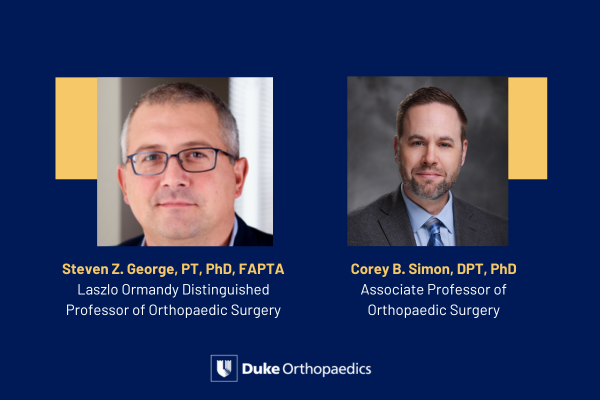
This collaborative study titled Hip-focused Physical Therapy (PT) versus Spine-Focused Physical Therapy for Older Adults with Chronic Low Back Pain at Risk for Mobility Decline (MASH): a Multicenter, Single-Masked, Randomized Controlled Trial was published in The Lancet: Rheumatology, an internationally leading journal for musculoskeletal research.
It was a multi-center trial led by the University of Delaware and involved the University of Pittsburgh and Duke University. Steven George, PT, PhD, FAPTA, Lazlo Ormandy Distinguished Professor of Orthopaedic Surgery, was the site principal investigator, while Corey Simon, PhD, Associate Professor of Orthopaedic Surgery, was a co-investigator. Multiple colleagues and students collaborated in the Duke Orthopaedic Surgery department, including our Doctor of Physical Therapy (DPT) Division and Duke PT/OT.
Duke Ortho team supporting the research effort and site:
• JaNell Dupree, MPH (clinical research coordinator)
• Michael Schmidt, PT, DPT, MHA (interventionist)
• Preston Roundy, PT, DPT, OCS (interventionist)
• Lindsay Ballengee, PT, DPT, GCS (study oversight)
• Hannah Zhao (Duke DPT Class of ’25)
• Josh Allen, PT, DPT (Duke DPT Class of ’22)
• Ali Lonner, PT, DPT (Duke DPT Class of ’23)
• Riley Kahan, MS (Duke MBS Class of ’22)
The trial was one of the first to investigate matched physical therapy care, specifically, physical therapy tailored to an at-risk subgroup of older adults with chronic low back pain and accompanying hip pain and muscle weakness. The control group in the study was traditional spine physical therapy.
The study team found that both treatment arms improved in walking speed. Still, the hip-focused therapy demonstrated less low back pain-related disability after an eight-week intervention but no difference at six months.
The study also found that 46 percent of the participants in the hip-focused group, compared to 33 percent in the spine-focused group, had clinically meaningful disability scores, as demonstrated by a 50 percent or more significant reduction in disability scores. Meanwhile, 53 percent of the hip-focused group, compared to 60 percent in the spine-focused group, showed clinically meaningful improvements in gait speed. Finally, the hip-focused group demonstrated better chair-rise performance at six months and walking endurance at eight weeks and six months.
“This was an exciting and highly innovative study for several reasons. First, research is slow to catch up to the prevalence and impact that chronic low back pain has on older adults. Studies in the subfield of geriatric low back pain are crucial since low back pain is a leading contributor to disability worldwide, and its prevalence is rising with the aging population,” said Dr. Simon.
He continued, “This study is part of a novel research program to identify a high-risk clinical phenotype and to deliver matched physical therapy care based on signs, symptoms, and influential factors. Participants not only had low back pain but also hip pain and weakness. Previously, older adults presenting with this combination had worse longer-term pain and disability outcomes. As such, we must work to optimize treatment, particularly for this at-risk subgroup. Overall, the team is excited to contribute to an accumulating body of research to demonstrate the impact of pain on disability in older adults with low back pain, as well as the modifiability of disability through non-pharmacological and non-surgical interventions.”
Congratulations to the Duke Orthopaedics research team!